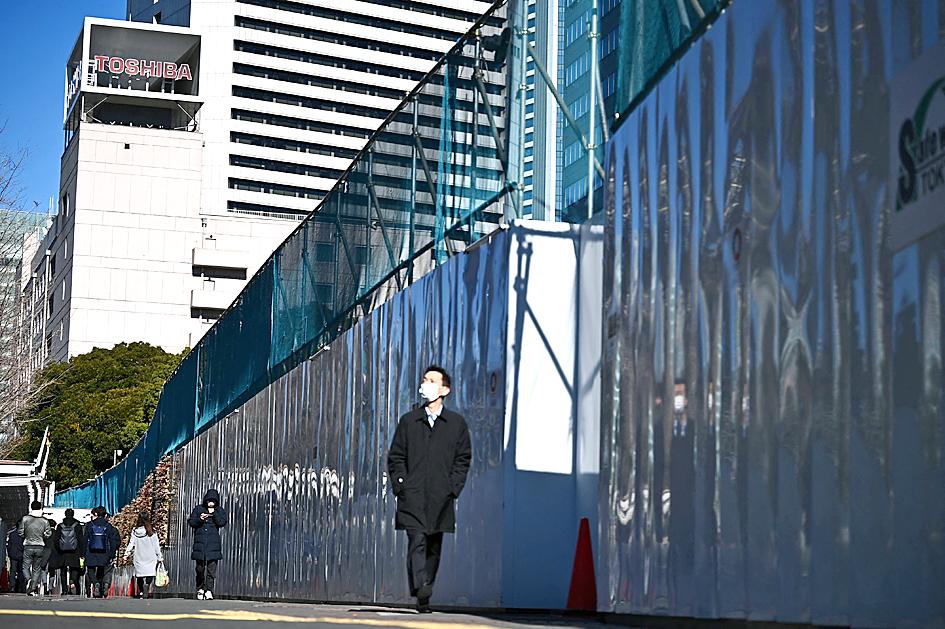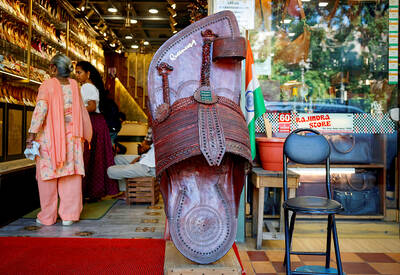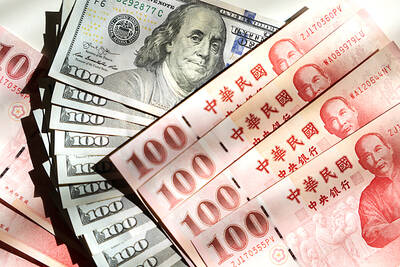Toshiba Corp yesterday announced plans to split into two companies, revising a controversial proposal to divide into three following a tumultuous period for the storied industrial conglomerate.
The group said it plans to spin off its device segment, including its semiconductor business, in a bid to speed up decisionmaking and boost stock performance.
Shareholders, who have clashed with management on the best way forward for the troubled company, must still approve the proposal in a vote expected next month.

Photo: AFP
The original spin-off plan faced stiff opposition from some key investors.
The firm also said it would unload its stake in air-conditioning business Toshiba Carrier Corp, and seek to sell its elevator and lighting units.
“We believe a spin-off is optimal,” Toshiba president and CEO Satoshi Tsunakawa told investors, promising it would “enable more agile and flexible operations.”
He said the sprawling business “struggled with the conglomerate discount and slowness in decisionmaking” in the past, and streamlining operations would allow investors to choose the portion of the business that interested them.
Toshiba initially unveiled a plan to split into three in November last year, in what analysts called a test case for other Japanese giants.
However, yesterday it said that “since this is the first large-scale spin-off transaction in Japan ... it turned out there were obstacles which were not initially expected.”
Among those were higher-than-expected costs, and an extensive process to list the two new entities.
A two-way split instead “can significantly reduce separation costs, secure financial soundness for each company, and significantly reduce spin-off uncertainty,” the company said.
The spin-off is expected to cost ¥20 billion (US$174 million) over two years, with running costs also increasing by ¥13 billion a year.
However, Tsunakawa said that would be offset by plans to reduce operating costs by ¥30 billion annually.
The Japanese giant wants the split finalized by the second half of the 2022-2023 fiscal year, but it could yet face shareholder opposition.
Toshiba dates back to 1875, and was once a symbol of Japan’s advanced technological and economic power, but it has been mired in turmoil for several years.
Last year, shareholders voted to oust the board’s chairman after a series of scandals and losses, in a rare victory for activist investors in corporate Japan.
As part of the overhaul, the company yesterday declared Toshiba Tec Corp, and its air-conditioning, elevator and lighting units “non-core businesses.”
It has already agreed to the sale of Toshiba Carrier to the US-based Carrier Corp in a deal reportedly worth about ¥100 billion.
The conglomerate currently owns 60 percent of the air-con company’s shares and is to retain only 5 percent when the sale is completed later this year.
It said it hoped to reach deals to offload the elevator and lighting units within the next two months.

MARKET LEADERSHIP: Investors are flocking to Nvidia, drawn by the company’s long-term fundamntals, dominant position in the AI sector, and pricing and margin power Two years after Nvidia Corp made history by becoming the first chipmaker to achieve a US$1 trillion market capitalization, an even more remarkable milestone is within its grasp: becoming the first company to reach US$4 trillion. After the emergence of China’s DeepSeek (深度求索) sent the stock plunging earlier this year and stoked concerns that outlays on artificial intelligence (AI) infrastructure were set to slow, Nvidia shares have rallied back to a record. The company’s biggest customers remain full steam ahead on spending, much of which is flowing to its computing systems. Microsoft Corp, Meta Platforms Inc, Amazon.com Inc and Alphabet Inc are

Luxury fashion powerhouse Prada SpA has acknowledged the ancient Indian roots of its new sandal design after the debut of the open-toe footwear sparked a furor among Indian artisans and politicians thousands of miles from the catwalk in Italy. Images from Prada’s fashion show in Milan last weekend showed models wearing leather sandals with a braided design that resembled handmade Kolhapuri slippers with designs dating back to the 12th century. A wave of criticism in the media and from lawmakers followed over the Italian brand’s lack of public acknowledgement of the Indian sandal design, which is named after a city in the

The US overtaking China as Taiwan’s top export destination could boost industrial development and wage growth, given the US is a high-income economy, an economist said yesterday. However, Taiwan still needs to diversify its export markets due to the unpredictability of US President Donald Trump’s administration, said Chiou Jiunn-rong (邱俊榮), an economics professor at National Central University. Taiwan’s exports soared to a record US$51.74 billion last month, driven by strong demand for artificial intelligence (AI) products and continued orders, with information and communication technology (ICT) and audio/video products leading all sectors. The US reclaimed its position as Taiwan’s top export market, accounting for

INVESTOR RESILIENCE? An analyst said that despite near-term pressures, foreign investors tend to view NT dollar strength as a positive signal for valuation multiples Morgan Stanley has flagged a potential 10 percent revenue decline for Taiwan’s tech hardware sector this year, as a sharp appreciation of the New Taiwan dollar begins to dent the earnings power of major exporters. In what appears to be the first such warning from a major foreign brokerage, the US investment bank said the currency’s strength — fueled by foreign capital inflows and expectations of US interest rate cuts — is compressing profit margins for manufacturers with heavy exposure to US dollar-denominated revenues. The local currency has surged about 10 percent against the greenback over the past quarter and yesterday breached